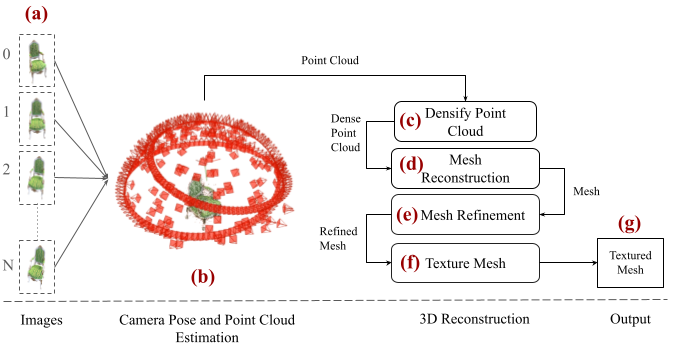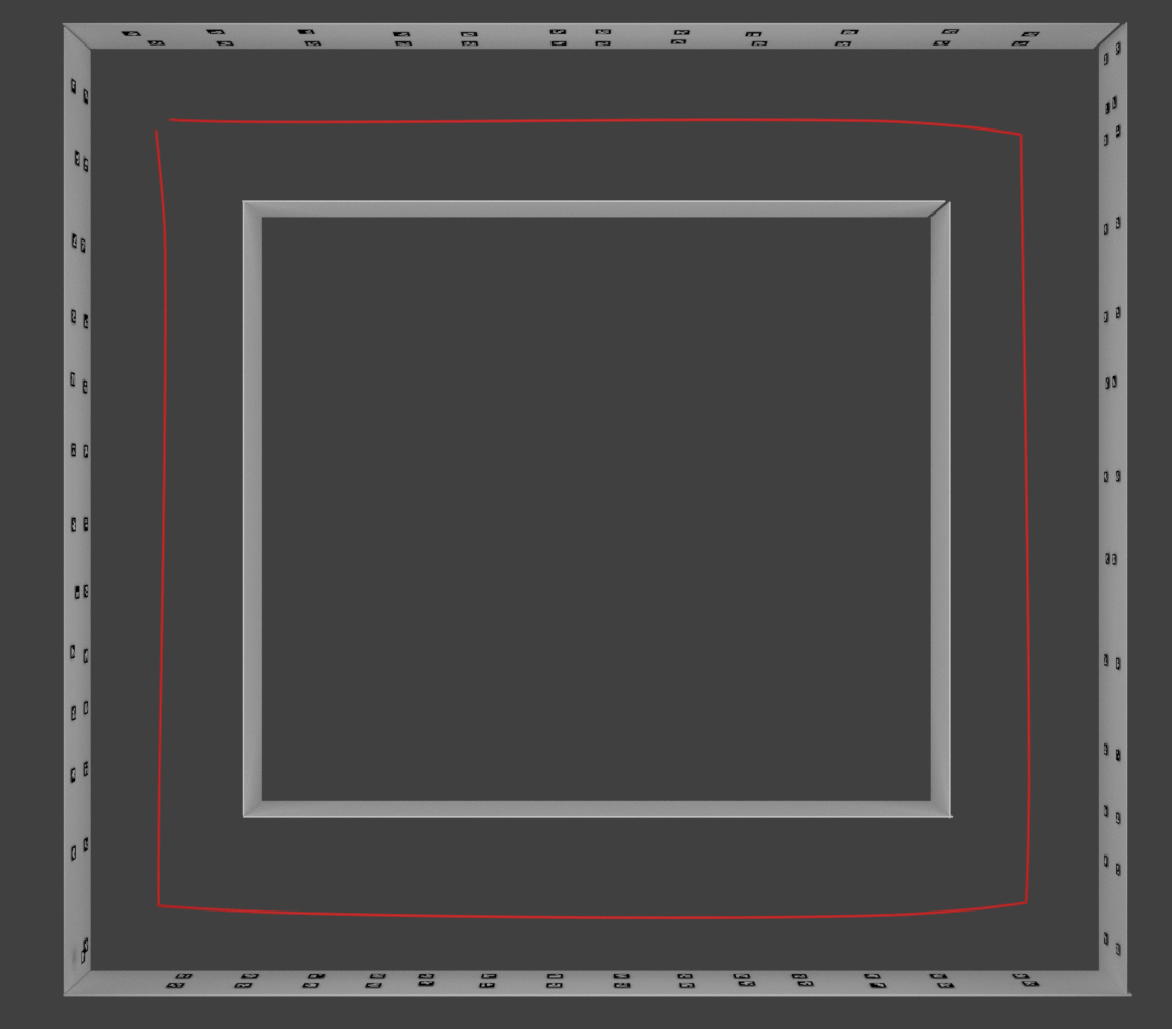SfM on-the-fly: Get better 3D from What You Capture

0
🤷
Sign in to get full access
Overview
- In the last two decades, Structure from Motion (SfM) has been a constant research focus in fields like photogrammetry, computer vision, and robotics.
- Real-time performance for SfM is a more recent area of growing interest.
- This work builds upon the original on-the-fly SfM approach and presents an updated version with three key advancements.
Plain English Explanation
The paper describes improvements to a technique called on-the-fly SfM, which can quickly create 3D models from images. The authors have made three main changes to make this process even better:
- Faster Image Matching: They use a special data structure called Hierarchical Navigable Small World (HNSW) graphs to more quickly identify which images overlap and can be used together.
- Improved 3D Reconstruction: They have developed a "self-adaptive weighting strategy" to make the 3D reconstruction process more robust and accurate.
- Collaborative 3D Reconstruction: The system now supports multiple devices working together, allowing them to seamlessly combine their 3D models into a complete scene.
These advancements help the on-the-fly SfM approach generate more complete and accurate 3D models in less time.
Technical Explanation
The paper builds on the original on-the-fly SfM approach by introducing three key improvements:
-
Real-Time Image Matching: The authors employ Hierarchical Navigable Small World (HNSW) graphs to more efficiently identify overlapping image pairs, a critical step for SfM. This allows them to find true positive matches faster.
-
Robust Hierarchical Bundle Adjustment: They propose a self-adaptive weighting strategy for the hierarchical local bundle adjustment, which improves the overall quality of the 3D reconstructions.
-
Collaborative SfM: The system now supports multiple agents working together, enabling them to seamlessly merge their individual 3D reconstructions into a single, complete scene model.
Comprehensive experiments demonstrate that this updated "on-the-fly SfMv2" approach can generate more complete and robust 3D models in a highly time-efficient manner.
Critical Analysis
The paper introduces several valuable improvements to the on-the-fly SfM pipeline. The use of HNSW graphs for faster image matching is a clever optimization that can significantly speed up the overall process. Additionally, the self-adaptive weighting strategy for bundle adjustment and the support for collaborative reconstruction are thoughtful enhancements that enhance the robustness and completeness of the 3D models.
However, the paper does not provide much detail on the specific algorithmic improvements or their theoretical underpinnings. It also lacks a comprehensive comparison to other state-of-the-art SfM methods, which would help contextualize the performance gains. Furthermore, the paper does not discuss potential limitations or areas for future research, such as how the system might handle challenging lighting conditions, occlusions, or large-scale scenes.
Conclusion
This work presents a series of advancements to the on-the-fly SfM technique, resulting in a more efficient and effective 3D reconstruction pipeline. The key improvements around faster image matching, robust hierarchical bundle adjustment, and collaborative reconstruction enable the generation of more complete and accurate 3D models in less time. While the paper lacks some technical details and a more thorough comparative analysis, the presented approach represents a valuable contribution to the field of real-time 3D reconstruction.
This summary was produced with help from an AI and may contain inaccuracies - check out the links to read the original source documents!
Related Papers
🤷

0
SfM on-the-fly: Get better 3D from What You Capture
Zongqian Zhan, Yifei Yu, Rui Xia, Wentian Gan, Hong Xie, Giulio Perda, Luca Morelli, Fabio Remondino, Xin Wang
In the last twenty years, Structure from Motion (SfM) has been a constant research hotspot in the fields of photogrammetry, computer vision, robotics etc., whereas real-time performance is just a recent topic of growing interest. This work builds upon the original on-the-fly SfM (Zhan et al., 2024) and presents an updated version with three new advancements to get better 3D from what you capture: (i) real-time image matching is further boosted by employing the Hierarchical Navigable Small World (HNSW) graphs, thus more true positive overlapping image candidates are faster identified; (ii) a self-adaptive weighting strategy is proposed for robust hierarchical local bundle adjustment to improve the SfM results; (iii) multiple agents are included for supporting collaborative SfM and seamlessly merge multiple 3D reconstructions into a complete 3D scene when commonly registered images appear. Various comprehensive experiments demonstrate that the proposed SfM method (named on-the-fly SfMv2) can generate more complete and robust 3D reconstructions in a high time-efficient way. Code is available at http://yifeiyu225.github.io/on-the-flySfMv2.github.io/.
Read more7/16/2024


0
Global Structure-from-Motion Revisited
Linfei Pan, D'aniel Bar'ath, Marc Pollefeys, Johannes L. Schonberger
Recovering 3D structure and camera motion from images has been a long-standing focus of computer vision research and is known as Structure-from-Motion (SfM). Solutions to this problem are categorized into incremental and global approaches. Until now, the most popular systems follow the incremental paradigm due to its superior accuracy and robustness, while global approaches are drastically more scalable and efficient. With this work, we revisit the problem of global SfM and propose GLOMAP as a new general-purpose system that outperforms the state of the art in global SfM. In terms of accuracy and robustness, we achieve results on-par or superior to COLMAP, the most widely used incremental SfM, while being orders of magnitude faster. We share our system as an open-source implementation at {https://github.com/colmap/glomap}.
Read more7/30/2024


0
MVSBoost: An Efficient Point Cloud-based 3D Reconstruction
Umair Haroon, Ahmad AlMughrabi, Ricardo Marques, Petia Radeva
Efficient and accurate 3D reconstruction is crucial for various applications, including augmented and virtual reality, medical imaging, and cinematic special effects. While traditional Multi-View Stereo (MVS) systems have been fundamental in these applications, using neural implicit fields in implicit 3D scene modeling has introduced new possibilities for handling complex topologies and continuous surfaces. However, neural implicit fields often suffer from computational inefficiencies, overfitting, and heavy reliance on data quality, limiting their practical use. This paper presents an enhanced MVS framework that integrates multi-view 360-degree imagery with robust camera pose estimation via Structure from Motion (SfM) and advanced image processing for point cloud densification, mesh reconstruction, and texturing. Our approach significantly improves upon traditional MVS methods, offering superior accuracy and precision as validated using Chamfer distance metrics on the Realistic Synthetic 360 dataset. The developed MVS technique enhances the detail and clarity of 3D reconstructions and demonstrates superior computational efficiency and robustness in complex scene reconstruction, effectively handling occlusions and varying viewpoints. These improvements suggest that our MVS framework can compete with and potentially exceed current state-of-the-art neural implicit field methods, especially in scenarios requiring real-time processing and scalability.
Read more7/19/2024


0
MCGMapper: Light-Weight Incremental Structure from Motion and Visual Localization With Planar Markers and Camera Groups
Yusen Xie, Zhenmin Huang, Kai Chen, Lei Zhu, Jun Ma
Structure from Motion (SfM) and visual localization in indoor texture-less scenes and industrial scenarios present prevalent yet challenging research topics. Existing SfM methods designed for natural scenes typically yield low accuracy or map-building failures due to insufficient robust feature extraction in such settings. Visual markers, with their artificially designed features, can effectively address these issues. Nonetheless, existing marker-assisted SfM methods encounter problems like slow running speed and difficulties in convergence; and also, they are governed by the strong assumption of unique marker size. In this paper, we propose a novel SfM framework that utilizes planar markers and multiple cameras with known extrinsics to capture the surrounding environment and reconstruct the marker map. In our algorithm, the initial poses of markers and cameras are calculated with Perspective-n-Points (PnP) in the front-end, while bundle adjustment methods customized for markers and camera groups are designed in the back-end to optimize the 6-DOF pose directly. Our algorithm facilitates the reconstruction of large scenes with different marker sizes, and its accuracy and speed of map building are shown to surpass existing methods. Our approach is suitable for a wide range of scenarios, including laboratories, basements, warehouses, and other industrial settings. Furthermore, we incorporate representative scenarios into simulations and also supply our datasets with pose labels to address the scarcity of quantitative ground-truth datasets in this research field. The datasets and source code are available on GitHub.
Read more5/28/2024